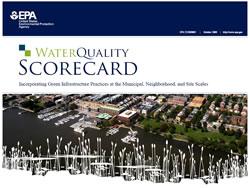Incorporating Green Infrastructure Practices at the Municipal, Neighborhood, and Site Scale
Many communities face challenges when balancing water quality protection with accommodating new growth and development. Conventional development practices cover large areas with roads, driveways, and buildings. Rainwater cannot infiltrate these impervious surfaces, running off the land at much higher levels than would naturally occur. Each time it rains, the collective force of this runoff scours streams, erodes stream banks, and carries large quantities of sediment and pollutants into water bodies.
Communities are recognizing the importance of managing how development affects water quality at the municipal, neighborhood, and site levels. Green infrastructure is a comprehensive approach to water quality protection, defined by a range of natural and built systems applicable at all three scales.
EPA developed the Water Quality Scorecard: Incorporating Green Infrastructure Practices at the Municipal, Neighborhood, and Site Scale (2009) to help local governments identify opportunities to better protect water quality by removing barriers and revising and creating codes, ordinances, and incentives. The scorecard guides municipal staff through a review of relevant local codes and ordinances across multiple departments to ensure that these codes work together to support a green infrastructure approach.
The scorecard is intended for municipalities of various sizes in rural, suburban, and urban settings, including those that have combined sewers, municipal separate storm sewers, or limited or no stormwater infrastructure. It can help municipal staff, stormwater managers, planners, and other stakeholders better understand where a municipality's land development regulations and other ordinances might present barriers or opportunities to implementing a comprehensive approach to protecting water quality.
Find more resources on smart growth and water.
You may need a PDF reader to view some of the files on this page. See EPA’s About PDF page to learn more.
